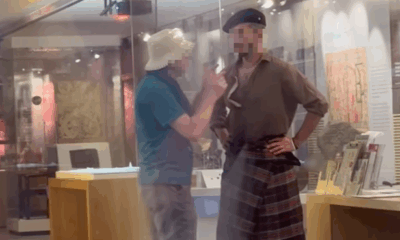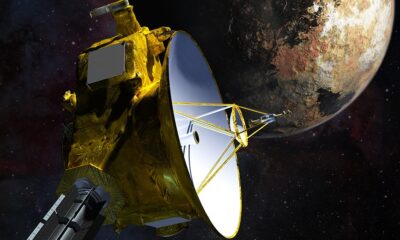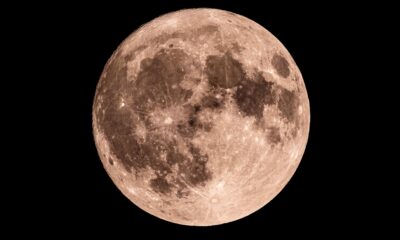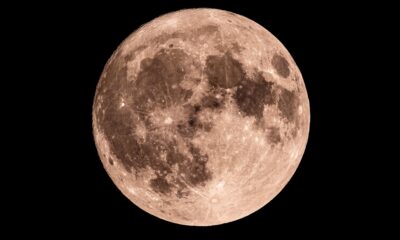Science
Discover the Waxing Gibbous Moon Phase on August 3, 2025

As of August 3, 2025, the moon is currently in its Waxing Gibbous phase, appearing 69% illuminated. This phase is part of the lunar cycle, which spans approximately 29.5 days, during which various moon phases occur as the moon orbits Earth, reflecting sunlight. According to NASA, this phase will provide ample opportunity for observation, making tonight an excellent time for skywatchers.
The Waxing Gibbous phase signifies that more than half of the moon’s surface is lit but not yet fully illuminated. As this is day 10 of the lunar cycle, observers can expect to see significant lunar features without the need for visual aids. Notable formations visible with the naked eye include the Copernicus Crater, Mare Fecunditatis, and Mare Crisium. For those equipped with binoculars, additional craters such as the Aphonsus Crater and Posidonius Crater will come into view, along with the Mare Frigoris.
For more serious lunar observers, telescopes will reveal even more detail. Features such as the Rima Arladaeus, the Descartes Highlands, and the Fra Mauro Highlands can be discerned. The Fra Mauro Highlands is particularly significant, as it is the landing site of the Apollo 14 mission, making it a point of interest for both amateur and professional astronomers.
The next full moon will occur on August 9, 2025. This event follows the last full moon, which took place on July 10, 2025. Understanding the moon’s phases is essential for both casual observers and those interested in lunar studies.
The moon phases arise from the 29.5-day cycle of the moon’s orbit, which alters the angles between the Sun, Moon, and Earth. As the moon orbits Earth, the amount of sunlight that reflects off its surface changes, leading to the various phases we observe. Each phase has distinct characteristics, including:
– **New Moon**: The moon is positioned between Earth and the Sun, rendering it invisible from our perspective.
– **Waxing Crescent**: A small sliver of light appears on the right side.
– **First Quarter**: Half of the moon’s surface is illuminated.
– **Waxing Gibbous**: More than half is lit, but it is not yet full.
– **Full Moon**: The entire face of the moon is illuminated and fully visible.
– **Waning Gibbous**: The moon begins to lose light from the right side.
– **Last Quarter**: Half of the moon is lit again, but now the left side is illuminated.
– **Waning Crescent**: A thin sliver of light remains on the left side before the cycle restarts.
This cyclical pattern can enhance our understanding of not only the moon but also the influences it exerts on Earth, including tides and natural phenomena. As the moon continues its journey through the night sky, it offers a unique opportunity for observation and appreciation of our celestial neighbor.
-

 Politics3 weeks ago
Politics3 weeks agoPlane Crash at Southend Airport Claims Four Lives After Takeoff
-

 Top Stories3 weeks ago
Top Stories3 weeks agoAustralian Man Arrested for Alleged Damage to Stone of Destiny
-

 Business3 weeks ago
Business3 weeks agoTrump’s “One Big Beautiful Bill” Faces Economic Scrutiny
-

 Business3 weeks ago
Business3 weeks agoNew Study Links Economic Inequality to Lower Well-Being Globally
-

 Entertainment4 days ago
Entertainment4 days agoEmmerdale Characters Face Danger as Stabbing Shakes Village
-

 Sports3 weeks ago
Sports3 weeks agoSheffield United’s Young Talent Embraces Championship Opportunity
-

 Lifestyle3 weeks ago
Lifestyle3 weeks agoBrits Identify Adulting Challenges: Cleaning, Cooking, and Time Woes
-

 Health3 weeks ago
Health3 weeks agoAI Tool EAGLE Streamlines Lung Cancer Mutation Detection
-

 Sports3 weeks ago
Sports3 weeks agoEverton Pursues Johan Bakayoko as Transfer Deadline Approaches
-

 Science3 weeks ago
Science3 weeks agoStudy Reveals Widespread Flooding in North Carolina Exceeds Expectations
-

 Politics3 weeks ago
Politics3 weeks agoUncertain Future for The Royal Albert Pub as Landlord Departs
-

 Science3 weeks ago
Science3 weeks agoNASA’s New Horizons Demonstrates Innovative Star Navigation Method



















